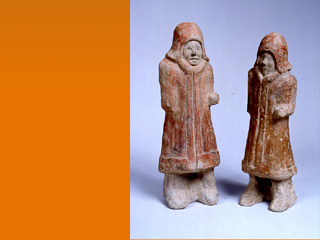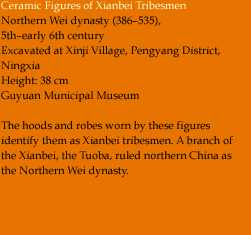 |
|
 |


I have heard of men using doctrines of our great land to change barbarians, but I have never heard of any being changed by barbarians — Mencius (c.371–c.289 B.C.E.) The nomads of China's northern borders are frequently portrayed in its histories as barbarians bent only on pillage and destruction. The reality was much more complex. The Chinese and the nomads warred, but they also traded and intermarried, enriching the societies and cultures of both. From the nomads, the Chinese received furs, leather, camels and horses, and technology such as the stirrup, as well as luxuries acquired by the nomads from farther west. Nomads coveted not only the products of the Chinese, such as silk, but their land. Conquest, however, was often followed by the abandonment of a true nomadic life in favor of a more sedentary one and by an intermingling of nomadic and Chinese customs. Between the fourth and sixth centuries C.E., a series of overlapping short-lived dynasties and kingdoms of nomadic origin jostled for control of northern and northwestern China. Of those that gained control of Gansu, the various Liang kingdoms (314–439), Northern Wei (386–535), and Northern Zhou (557–581) were the most influential. The rulers of these kingdoms were of various origins — the Northern Wei, for instance, were a branch of the Xianbei, a confederation of tribes from the northeast speaking a language that contained Turkish and Mongolian elements. The turbulent situation is reflected in the contents of tombs shown in this section. The nomadic origins of the elite and the endemic militarism of the period find expression in tomb figures with non-Chinese features and clothing and of armored warriors. Other figures, however, portray civilian officials drawn from the Chinese populace. Foreign luxury goods and coins found in the tombs reveal that, despite the political turmoil, trade with the West continued to flourish. These nomad dynasties, moreover, became major patrons of Buddhism, establishing translation centers for Buddhist scriptures, founding temples, and commissioning images and other Buddhist paraphernalia. |
||||